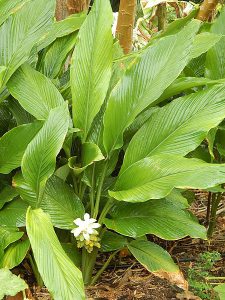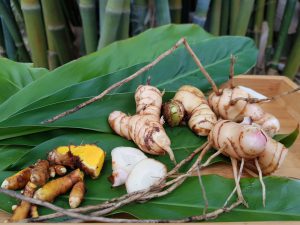
Cultivated as food and medicine for thousands of years, ginger, turmeric and galangal are members of the ginger family that are both ornamental and edible. They are prized worldwide for their edible, underground, tuber-like rhizomes. They are key ingredients in many cultures’ cuisines and are also high in antioxidants and have anti-inflammatory properties. These gingers are not commercially cultivated on a wide scale in Florida, but all can easily be grown in your garden.
Growing gingers
Spring is the best time to plant gingers in Central Florida, as they will have enough time to grow and be harvested in our extensive warm season before cold weather comes around again. Select a location that is well-drained and partly shady. It is not ideal to plant under tree canopies because the tree roots will be damaged and interfere with digging up the rhizomes when you harvest them. Gingers need well-drained soil with plenty of organic matter. Ginger rhizomes or potted plants can be purchased through specialty nurseries, or you can simply buy the rhizomes from a grocery and plant them. Cut off 2-inch sections of rhizome and plant 2 inches deep. Regular moisture is important, but gingers cannot tolerate soggy roots. Here are three great gingers to grow:
- Ginger (Zingiber officianale) – This is the species of edible ginger that is most commonly known and used. It is an essential ingredient in many Asian dishes and has numerous health uses. Raised beds are a great way to grow this ginger. The plant has attractive foliage that will grow to 4 ft. tall. It blooms infrequently and does not have very showy flowers. Younger rhizomes are more tender and mildly flavored than older ones and can be harvested 5-10 months after planting.
- Turmeric (Curcuma longa) – Turmeric is a common ingredient in Indian and Persian cuisine and has grown in popularity as a health supplement. This showy plant will grow to only 3 ft. tall and has a smaller rhizome, so it is well-suited for growing in containers as well as raised beds or the landscape. Container growing also allows you to relocate the plants to a protected location during winter, as turmeric is very cold sensitive. The flowers are highly ornamental and long-blooming. The rhizomes are ready to harvest 8-11 months after planting. Both the turmeric rhizomes and leaves are used in cooking. Warning: turmeric rhizome will stain hands and surfaces yellow!
- Greater galangal (Alpinia galanga) – Galangal is often used in Thai and Vietnamese cooking. It contains galangin, a compound being studied for its potential cancer-fighting properties. Galangal is not a suitable substitute for ginger in cooking, as the texture is courser and flavor is very different. The plant does well planted directly in the landscape; it grows to 8 ft. tall and will form a large clump if not harvested regularly.
Harvesting and preserving

These gingers are all cold-sensitive perennials that can die back in the winter, and usually regrow in the spring. You can harvest small sections of your planting at a time and leave some growing year-round, however, you may want to harvest all rhizomes seasonally to prevent damage from soil pests. To replant after harvesting in the fall, take 2-inch sections of the rhizomes and plant them 2 inches deep in pots in a sheltered location; relocate them to the garden in the spring.
For the best flavor, use rhizomes of these gingers within a few days of harvest. They will hold for a short time wrapped in paper towels in the refrigerator. The easiest way to keep them long-term is to slice the clean rhizomes, place sheets of wax paper or plastic wrap between the slices and freeze them. You can also puree or juice them, then freeze in ice cube trays and put cubes in a freezer bag.
While the plants featured in this article are widely used as food and generally considered safe to consume, some individuals may have sensitivities to some foods. Turmeric may cause stomach upset in some people, and those predisposed to kidney stones or gallstones should consult with a physician before consuming it. Persons who are pregnant should consult with a physician before consuming gingers.
For gardening, farming and food classes and information, or finding plant sources, contact the UF IFAS Extension-Osceola County: 321-697-3000.
Source: UF/IFAS Pest Alert



